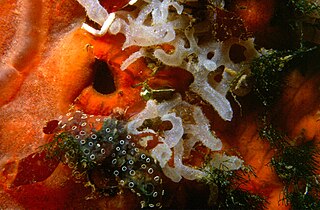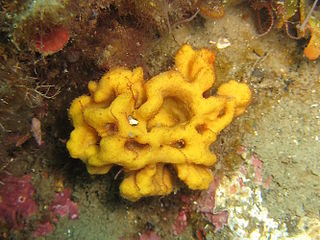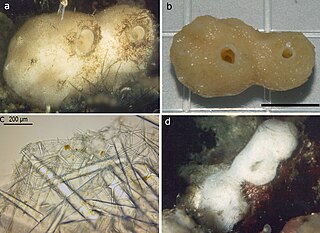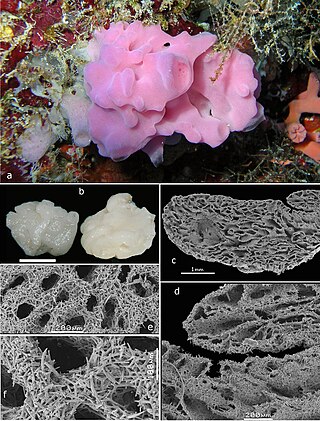
Leucosolenia is a genus of calcareous sponges belonging to the family Leucosoleniidae. Species of this genus usually appear as groups of curved vases, up to 2 cm long, each ending in an osculum. The overall shape is sometimes likened to a tiny bunch of bananas. They are most often observed in tide pools, clustered around the base of seaweeds or on rocks, and occur in a variety of colours, usually rather pale. Its canal system is of asconoid type. The colony consists of few simple vase-like, cylindrical individuals each terminating in an osculum and united at their bases by irregular horizontal tubes. Leucosolenia reproduces both asexually and sexually. asexual reproduction by budding and sexual reproduction takes place by formation of gametes, i.e., ova and sperms. Lecosolenia is hermaphrodite, because both the gametes are formed in the body of same individual. Sponges are mostly asymmetrical, but Leucosolenia is symmetrical.

Grantia is a genus of calcareous sponges belonging to the family Grantiidae. Species of the genus Grantia contain spicules and spongin fibers.

Axinella is a genus of sponges in the family Axinellidae first described in 1862 by Eduard Oscar Schmidt. Species of Axinella occur in the Indian and Pacific Oceans. Most of these sponges are smaller than 20 cm, and have a yellow or orange colour.
Hymeniacidon is a genus of sea sponges in the class Demospongiae. Some members of the genus are known to be mobile, achieving speeds of between 1 and 4 mm per day.

Leucandra is a genus of calcareous sponge belonging to the family Grantiidae. Its earliest known fossils are from the Jurassic.

Leuconia is a genus of calcareous sponges in the family Baeriidae. It was described by English anatomist and zoologist Robert Edmond Grant in 1833.

Sycon is a genus of calcareous sponges belonging to the family Sycettidae. These sponges are small, growing up to 7.5 cm with a length from 2.5 to 7.5 cm, and are tube-shaped and often white to cream in colour. They are known to aquarium hobbyists as "Pineapple" or "Q-Tip" sponges, and are frequent "hitchhikers" accidentally brought in.

Stelletta is a genus of sea sponges belonging to the family Ancorinidae.

Arturia is a genus of calcareous sponge in the family Clathrinidae which contains 14 species. It is named after Arthur Dendy, a prominent researcher of calcareous sponges. It was renamed Arturia in 2017 because the name Arthuria was already assigned to a genus of molluscs.

Mycale is a genus of demosponge with 240 recognised species in 11 subgenera. It has been a large genus with multiple subdivisions since it was first described in 1867.

Acanthella is a genus of sponges in the family Dictyonellidae, which was first described in 1862 by Eduard Oscar Schmidt. The type species is Acanthella acuta Schmidt, 1862.

Leucetta is a genus of sponges in the family Leucettidae, which was first described in 1872 by Ernst Haeckel. The type species is Leucetta primigenia Haeckel, 1872 by subsequent designation.
Vosmaeropsis macera is a species of calcareous sponge in the family Heteropiidae, and was first described in 1886 by Henry John Carter as Heteropia macera, and was later described as Vosmaeropsisis dendyi by Row and Hôzawa in 1931. It is the type species of the genus, Vosmaeropsis. The species epithet, macera, comes from the Latin, macer.
Vosmaeropsis complanatispinifera is a species of calcareous sponge in the family Heteropiidae, and was first described in 2015 by Cavalcanti, Bastos & Lanna. It is found off the Brazilian coast.
Vosmaeropsis recruta is a species of calcareous sponge in the family Heteropiidae, and was first described in 2015 by Cavalcanti, Bastos & Lanna. It is found off the Brazilian coast.
Heteropia is a genus of sponges in the family Heteropiidae, and was first described in 1886 by Henry John Carter. The type species by monotypy is Heteropia ramosa, which he first called Aphroceras ramosa in the very same publication.

Leucascus is a genus of sponges belonging to the family Leucascidae.

Raspailiidae is a family of sponges belonging to the order Axinellida.

Paraleucilla is a genus of calcareous sponges in the family Amphoriscidae.
Grantessa is a genus of sponges in the family Heteropiidae, and was first described in 188h by Lendenfeld.














